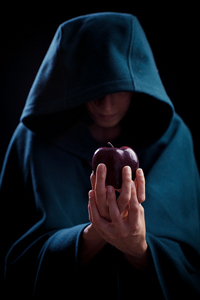
Source: the witch, riccardo bruni, Flickr
Do you remember the story of Snow White? She is offered an apple by an evil queen disguised as a witch. Of course, Snow White accepts the apple and bites into it with gusto. You want to yell, “Stop! Don’t eat that!” because you have information that Snow White doesn’t: the witch is evil, and the apple is poisonous. This kind of knowledge—when the audience reading a text or watching a play knows something the characters don’t—is a dramatic convention known as dramatic irony.
Dramatic irony occurs when the reader or audience has more information about what is going to take place or what might develop in the story than the characters do. As the reader or observer, you may know that a character is depending on someone untrustworthy or has unknown enemies long before the character figures it out. This dramatic convention helps us sympathize with the character because he or she is unaware of an unlucky fate that awaits. For example, because of what we know about the evil queen, we feel sorry for Snow White.

Source: Audience, iStockPhoto
The use of dramatic irony not only enhances a play or text, creating sympathy for a character, but it also keeps us engaged in the action by creating a sense of dread or nervous excitement. Dramatic irony helps us predict what will happen to the character(s). It is not limited only to plays or books but is also used in movies and TV shows, especially in the genres of suspense and horror.
Disney uses dramatic irony in many of its classics. Here are two examples:
- In Sleeping Beauty the Prince meets Briar Rose in the woods, but neither knows that the other is royalty (and Briar Rose doesn’t even know her own true identity because her real parents have hidden her since she was a child). The Prince’s father is horrified to learn that his son, the Prince, has fallen in love and wants to marry a commoner. They can’t be together, he says, but we know who Briar Rose really is, and we know they can.
- In the movie Shrek, the dramatic irony in the plot occurs when we find out that Princess Fiona is cursed and secretly turns into an ogre at night. Shrek, an ogre, falls in love with the human Fiona, totally unaware of her curse, until the end of the story.
Consider this quote by suspense film director Alfred Hitchcock:
There’s no suspense in putting a bomb under a character’s chair unless everyone in the audience knows it’s there and the character doesn’t.

Source: Blood-red “No!”, IPSI
That is dramatic irony. You are probably familiar with horror movies where you know the villain or monster is in the house, but the character in the movie doesn’t. When the character is about to enter the house, we scream, “No, don’t do it!” But he or she does it anyway. If only they could read our minds and know what we know.
Welcome to the lesson on dramatic irony; enter, if you dare!